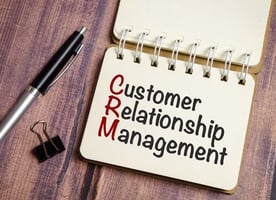There is a common experience of people who have been working with CRMs for a long time: the problem...
How much data is locked out of your CRM?
CRM is the core system for most companies as for their ability to grow and their efficiency in serving customers. Despite this, data quality issues very often arise: incomplete data, missing information, empty fields are some words describing a usual quality issue in CRM data. Although large amount of data is stored inside every day, there is still much remaining locked out: useful information that we may receive but never properly store it!
Have you ever written down the phone number of a potential customer on a sticky note? Do you sometimes leave important information about an order in different emails buried in your inbox? How common it is to have important info scattered in various files or even to printed papers? While being out in a meeting, don’t save a phone number in your mobile phone? How often do you make task lists in excel? In most of those cases the information will never make it to the CRM!
A waste of resources and a decrease in Data Quality
These practices lead to siloed information, which contradicts the very purpose of a CRM: to provide a unified, well-organized, and easily accessible database for all customer information.
The impact of this scattered information goes beyond simple disorganization. Imagine a salesperson calling a potential customer whose number they found on a forgotten note. The customer is likely confused, having no record of prior interaction. This fragmented approach creates a frustrating experience for the customer and hinders building rapport. Furthermore, valuable insights are lost when data isn't centralized. Marketing campaigns miss the mark without a complete understanding of customer preferences. Sales opportunities are lost because key details about past interactions or buying habits remain buried in emails or notebooks. By siloing information, businesses miss out on the big picture and the chance to leverage their customer data for maximum impact.
Resource Waste: Manually managing data outside the CRM is time-consuming and inefficient.
- Data Quality Decrease: Inconsistent and fragmented data reduces the overall quality and reliability of the information.
- Missed Opportunities: Sales and marketing efforts suffer due to the lack of incomplete understanding of customer preferences and histories.
- Poor Customer Experience: Customers get frustrated by interactions that show a lack of care and understanding of their case.
The root of the problem
It seems obvious that what this is not a desirable situation for a business or an organization. But why this issue is so common across different industries, company sizes and countries?
We tried to identify the basic reasons:
- Bad CRM implementation that does not facilitate the entry of specific information.
- Lack of training for users
- The old habit of writing down in paper.
- The extended use of our mobile in everyday life and work
- Missing or badly designed processes regarding the entry of data or any kind of control
- Lack of awareness of data quality issues
How bad is it? Is there a solution?
If we have some hints that critical information stays out of our CRM, we need to deal with it and not let it grow and become irreversible. As every case is different, it is recommended to make a thorough data quality assessment, to understand the extend of the problem and its characteristics. This is about identifying what kind and how much information is missing, having a full and detailed for every different record or field of our CRM.
Having the full picture of the problem we can design and implement the adequate solutions. As said before, every case is different and only a tailor-made solution can really solve the problem. Nevertheless, there are some general remedies that can be used in most cases and be adapted in the special characteristics of each one.
Technical solutions
- Re-configuration of specific CRM objects to make the process simpler or to enforce data completion in certain fields.
- Mobile CRM apps can help employees to easily capture data on the go (e.g., saving phone numbers, updating notes after a meeting).
- Email integrations can very easily (even automatically) import contact, orders, deals and other information and all relevant emails into the CRM.
- Web or email embedded forms that can be used to capture any kind of information into the CRM directly, eliminating the need for manual data entry.
- Automations that make the CRM easier to use and as the best way to convince employees about using the CRM to store all kinds of data.
- Automated controls and reminders focusing on specific types of information that is usually left out.
Organizational measures
- Comprehensive training for all CRM users on how to accurately and efficiently input information into the system, and on several tips and hints that can help them be familiar with its use.
- Promote data quality principles to foster a company culture that prioritizes data accuracy and completeness, based on Management commitment and regular communication on the matter.
- Establish a data quality policy with clear guidelines and processes for data collection, storage, and management.
- Regularly review and clean CRM data to remove duplicates, inconsistencies, and outdated information and other potential data quality issues.
CRM can be your most valuable tool
We would like to repeat it: every case is different, that is why a careful assessment is necessary before taking any action. It is though safe to say that by implementing such technical solutions and organizational measures much of the problem will be resolved.
The CRM is the tool for business growth and commercial efficiency. As technology continues to evolve, the capabilities of CRM systems will expand, offering new ways to capture, integrate, and utilize data. Unlocking the full potential of your CRM is not just about having the right technology; it’s about creating an ecosystem where data flows freely, is of high quality, and is used effectively by all members of the organization. By breaking down data silos, enhancing integration capabilities, improving data quality, and boosting user adoption, businesses can ensure that their CRM systems deliver on their promise of enhanced customer relationships and business growth. Investing in these strategies will not only unlock the data trapped outside your CRM but also transform how your business leverages data, driving efficiency, innovation, and sustained success in an ever-evolving market landscape.



